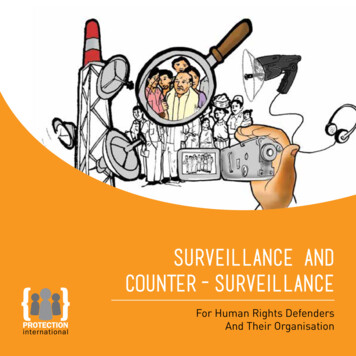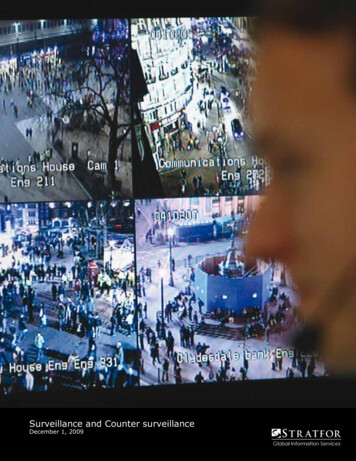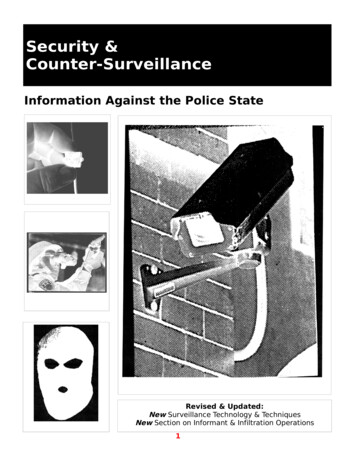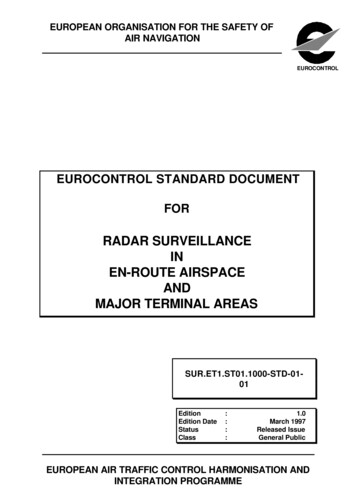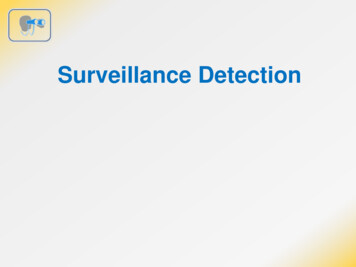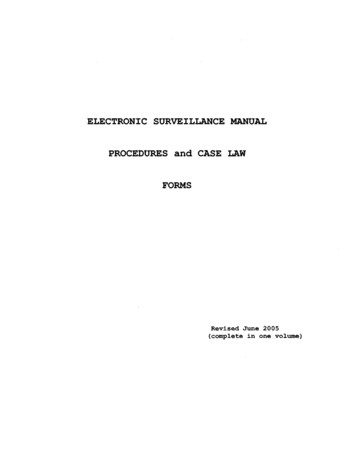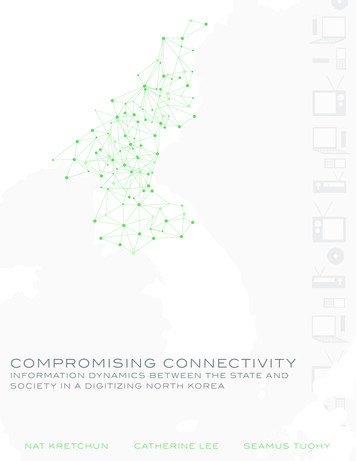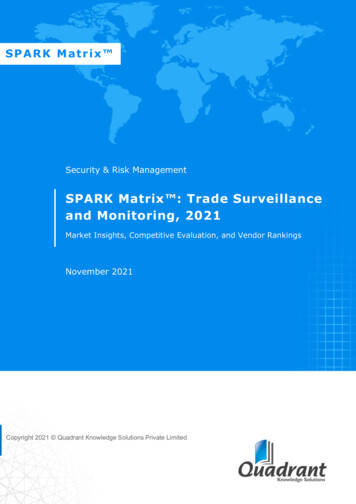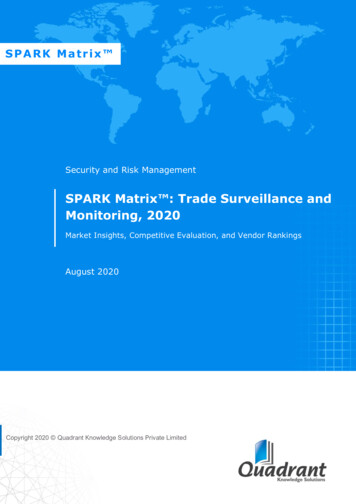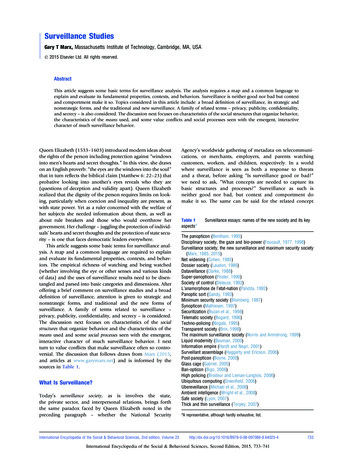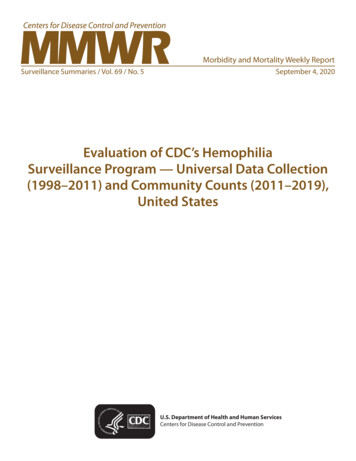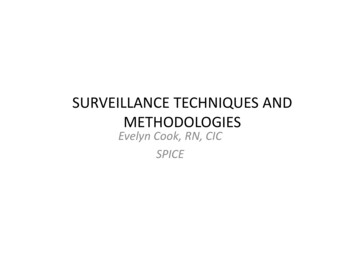
Transcription
SURVEILLANCE TECHNIQUES ANDMETHODOLOGIESEvelyn Cook, RN, CICSPICE
Goals of Surveillance Lecture Describe the recommended practices forsurveillance List the elements required for anorganization surveillance system Describe standardized definitions used forsurveillance Apply information to case studies
Key Concepts Surveillance is an essential component ofan effective infection prevention program.– Should be based on sound epidemiological andstatistical principles– Should be designed in accordance with currentrecommended practices and consist of definedelements– Plays a critical role in identifying outbreaks, emerginginfectious disease and bioterrorist events
Definitions Continual observation of a person or group,especially one suspected of doingsomething illegal (Bing Dictionary) Is the monitoring of the behavior,activities, or other changing information,usually of people for the purpose ofinfluencing, managing, directing, or“Local IP”protecting. (Wikipedia)
Definitions cont’d Disease surveillance is an epidemiologic practice bywhich the spread of disease, is monitored in orderto establish patterns of progression. The main roleHealthof disease surveillance is to predict, observe, andDepartmentminimize the harm caused by outbreak, epidemic,and pandemic situations, as well as increaseknowledge about which factors contribute to suchcircumstances. A key part of modern diseasesurveillance is the practice of disease casereporting.
Definition cont’d “Surveillance is a comprehensive method ofmeasuring outcomes and related processes of care,analyzing the data, and providing information tomembers of the healthcare team to assist inimproving those outcomes and processes” ObservationMonitor behaviorEstablish patterns/trendsMeasure outcomes, processes; Analyze data;feedback of data to improve outcomes andprocesses
Evolution of Surveillance Programs 1958: AHA recommended in response tooutbreaks of Staphylococcus aureus infectionsin hospitals. 1960’s: CDC recommended hospital baseprograms include surveillance 1976: TJC first included infection surveillance,prevention and control standards in itsaccreditation manual
The SENIC Project. Study on the Efficacy ofNosocomial Infection Control. CDC undertook in 1974 Three primary objectives: 1) to determine whether (and, if so, to what degree)the implementation of infection surveillance andcontrol programs (ISCPs) has lowered the rate ofnosocomial infection, 2) to describe the current status of ISCPs and infectionrates, and 3) to demonstrate the relationships amongcharacteristics of hospitals and patients, componentsof ISCPs, and changes in the infection rate.
SENIC Findings SENIC found that hospitals reduced theirnosocomial infection rates by approximately32% if their infection surveillance and controlprogram included four components: 1) appropriate emphases on surveillance activities andvigorous control efforts, 2) at least one full‐time infection‐control practitioner per250 beds, 3) a trained hospital epidemiologist, and 4) for surgical wound infections (SWIs), feedback of woundinfection rates to practicing surgeons.
Rational for conductingSurveillance Determine baseline (endemic) Early detection of epidemics (adverse outcomes) Assess the effectiveness of prevention and control measures Monitor the occurrence of adverse outcomes to identify riskfactors Observe practices to promote compliance Target performance improvement Compliance with regulations and accrediting agencies (includinghealth department) Monitor bioterrorism events Provide information for the education of healthcare personnelAPIC Text, 2015
New Developments in HAISurveillance [Past Decade] Continuing shift from acute care toambulatory, LTCF Decreased LOS across continuum of care Emerging and reemerging infectious diseases Bioterroism and syndromic surveillance Use of surveillance data to monitor non‐infectious events Active surveillance culturing Culture change promotes moving beyondbenchmarking and aiming for zero HAIs
National Healthcare SafetyNetwork (NHSN) NHSN is an internet‐based surveillancesystem that integrates the surveillancesystems previously managed separately inthe Division of Healthcare QualityPromotion (DHQP) at CDC– National Nosocomial Infections Surveillance(NNIS) system– Dialysis Surveillance Network (DSN)– National Surveillance System for HealthcareWorkers (NaSH)
Purposes of NHSNOriginal Collect data from a sample of US healthcarefacilities to permit valid estimation of the– magnitude of adverse events among patientsand healthcare personnel– adherence to practices known to be associatedwith prevention of healthcare‐associatedinfections (HAI) Analyze and report collected data to permitrecognition of trends
Purposes of NHSN Provide facilities with risk‐adjusted data that canbe used for inter‐facility comparisons and localquality improvement activities Assist facilities in developing surveillance andanalysis methods that permit timely recognitionof patient and healthcare personnel safetyproblems and prompt intervention withappropriate measures Conduct collaborative research studies withmembers
Purposes of NHSN“Ongoing” Facilities that participate in certain reportingprograms operated by the Centers forMedicare and Medicaid Services (CMS) do sothrough use of NHSN. Furthermore, some U.S. states use NHSN as ameans for healthcare facilities to submit dataon healthcare‐associated infections (HAIs)mandated through their specific statelegislation.
The Essentials of surveillance Know the protocol/criteriaConsistently apply the criteriaReport events meeting criteria; exclude those that don’tFailure to do so:–––––Breach of NHSN Rules of BehaviorDecreased usefulness of national comparative dataUnfair comparisons between facilitiesPossible validation discrepanciesPotential impact of CMS Inpatient quality Reporting score and facilityreimbursement Concerns about the criteria should be sent to NHSN‐NOTaddressed by non‐reporting of events or facility adjudicationThe Basics of NHSN Patient Safety Component Surveillance and Updates for 2017: Kathy Allen‐Bridson
NHSN ComponentsPatient SafetyDevice-associated moduleProcedure-associatedmoduleAntimicrobial Use andResistance ModuleMDRO/CDI ModuleHCP Safety OP DialysisLTCFBBF ExposureMDRO/C diffLabIDInfluenza s
Patient Safety ComponentModules Device‐associated CLABSI – Central line‐associated bloodstream infection CLIP – Central line insertion practices VAE – Ventilator‐associated events (adult locationsonly) VAP – Ventilator‐associated pneumonia (in pediatriclocations (in‐plan or off‐plan), or NICU and adultlocations (off‐plan) CAUTI – Catheter‐associated urinary tract infection Procedure‐associated SSI
Patient Safety Component Modules Antimicrobial Use and Resistance (AUR)– The primary objective of the Antimicrobial Useoption is to facilitate risk adjusted inter‐ and intra‐facility benchmarking of antimicrobial usage.– A secondary objective is to evaluate trends ofantimicrobial usage over time at the facility andnational levels
Patient Safety Component Modules Choices for Multidrug resistant organism(MDRO) and CDI Module:– LabID Event : (MRSA & C difficile)– Infection Surveillance– Prevention Process Measures– Active Surveillance Testing
Data Collection and Reporting Requirements forPatient Safety Component1. Submit a Monthly Reporting Plan toinform CDC which, if any, of the patientsafety modules will be used for thatmonth.2. Adhere to the selected module’sprotocol(s) exactly as described in theNHSN Manual Patient Safety ComponentProtocol3. Use surveillance methodology asdescribed in the Protocol
Data Collection and Reporting Requirements forPatient Safety Component4. Report events and appropriate summary or denominatordata indicated on the Plan to CDC within 30 days of the endof the month5. Submit data for at least one module for a minimum of 6months of the calendar year6. Complete an annual survey for your facility7. Pass quality control acceptance checks that assess the datafor completeness and accuracy.8. Agree to report to state health authorities adverse eventoutbreaks identified in the facility by the surveillancesystem and about which you are contacted by CDC.
Types of Surveillance Total (or Whole) House Surveillance All HAIs are monitored in the entire population Calculate rates for specific population (not anoverall facility wide rate) Targeted Surveillance Particular care units Infections related to medical devices Organisms of epidemiological importance Combination Surveillance Strategy Most use a combination and monitor targeted eventsthat occur in defined populations while concurrentlymonitoring select HAIs and laboratory reports fromhouse‐wide locationsExamples might be MRSA and C difficile house wide but CAUTIs inthe ICU only.
Surveillance Methods *Results with MS versus ES (HAIsin ICU) were: Sensitivity 40% vs 87% Specificity 94% vs 99%*Effectiveness of an automated surveillance system for intensive careunit-acquired infections: Vienna , Austria; 2006-2007
APIC Position Paper: The Importance of SurveillanceTechnologies in thePrevention of Healthcare‐Associated Infections (HAIs) Streamline and facilitate efficient review of relevantdata, promoting rapid identification of sentinel eventsand detection of outbreaks Expand and better define the scope of infectionprevention activities Reduce infection prevention department time spent onsurveillance and clerical tasks Improve response to public health issues Regulatory compliance Financial performance Potential to enhance antibiotic stewardship programs
Recommended Practices s the populationSelect the outcome or process forsurveillance and determine the time periodICRAUse surveillance definitionsCollect surveillance dataCalculate and analyze infection ratesApply risk stratification methodologyReport and use surveillance informationValidate surveillance methodologies andfindings
*Note: “In-plan” surveillance means that the facility hascommitted to following the NHSN surveillance protocol,in its entirety, for that particular event, as shown in thefacility’s NHSN monthly reporting plan. “Off-plan”surveillance is surveillance that is done because a facilityhas decided to track a particular event for internal use.Data that are entered into NHSN “off-plan” are notincluded in NSHN annual reports or other NHSNpublications. A facility makes no commitment to followthe NHSN protocol for “off-plan” events.
Using Surveillance Definitions Define clearly all data elements– outcome or process– “at risk” population– risk factors Use standardized written case definition(These are surveillance definitions and notclinical definitions!!!!!) Ifdefinition(CDC‐NHSN)change,highlightOthers may be trained to screen data sources for these infections,inmustreportsmandatorybut the IPmake the(rememberfinal determination.(NHSN)reporting)
Infection Window PeriodNADate of EventYesPOANAHAINARepeat Infection Time PeriodNASecondary BSI AttributionPeriod**See SSI specific guidanceLabIDVAENot ApplicableSSINot ApplicableKey Terms
Key Terms NHSN Infection Window Period: Defined as the 7‐days during which all site‐specificinfection criteria must be met. It includes the day thefirst positive diagnostic test that is an element of thesite‐specific infection criterion, was obtained, the 3calendar days before and the 3 calendar days after. For site‐specific infection criteria that do not include adiagnostic test, the first documented localized sign orsymptom that is an element of NHSN infection criterionshould be use define the window Date of Event: The date the first element used to meet an NHSN site‐specific infection criterion occurs for the first time withinthe seven‐day infection window period
Infection window period Diagnostic test examples*– Laboratory specimen collection– Imaging test– Procedure or exam– Physician diagnosis– Initiation of treatment Localized sign or symptom examples:– Diarrhea– Site specific painIf there is more than one use the most localizing test result, e.g., if trying to determine MBI‐LCBI, use the blood culture as opposed to ANC level– Purulent exudate
Key Terms Date of Event (DOE) The date the first element usedto meet an NHSN site‐specificinfection criterion occurs for thefirst time within the seven‐dayinfection window periodNote: The element MAY have been presentbefore the infection window period
Key Terms Present on Admission (POA)– When the date of “event” occurs during the POAtime period.– Defined as the day of admission to an inpatientlocation (calendar day 1), the 2 days beforeadmission, and the calendar day after admission.Hospital DayDate of EventClassification2 days before admitHospital Day 1POA1 day before admitHospital Day 1POAAdmission (Day 1)Hospital Day 1POADay 2Hospital Day 2POADay 3Hospital Day 3HAIDay 4Hospital Day 4HAIDay 5Hospital Day 5HAI
Present on Admission cont’Important Acceptable documentation: Patient‐reported signs or symptoms documented in themedical record by a healthcare professional (must be inyour facility medical record documentation). Physician diagnosis can be accepted only when physiciandiagnosis is an element of the specific infection criteria Infections in newborns with date of event on hospital day 1 orday 2 are considered POA. Day 3 or after are HAIs, includesacquired transplacentally (for example but not limited to:herpes simplex, toxoplasmosis, rubella, cytomegalovirus, orsyphilis) or as a result from passage through the birth canal.
Key Terms Healthcare‐associated Infection (HAI) The date of event occurs on or after the 3rd calendar day ofadmission to an inpatient location where day of admission iscalendar day1 Repeat Infection Timeframe (RIT) A 14‐day timeframe during which no new infections of the sametype are reported. The date of event is Day 1 of the 14 day RIT. Additional pathogens recovered during the RIT from the same typeof infection are added to the event. Applies during a patient’s single admission including the day ofdischarge and the day after. May have negative cultures during RIT Do not change device‐association determination during RIT(SUTI identified, foley placed and while still in RIT meets definition forCAUTI. Add pathogen to initial event and do not change the SUTI toCAUTI )
Key Terms Secondary BSI Attribution Period: Is the period in which a positive blood culture must becollected to be considered as a secondarybloodstream infection to a primary site infection This period includes the Infection Window Periodcombined with the Repeat Infection Timeframe (RIT).It is 14‐17 days in length depending upon the date ofevent. For SSI surveillance a 17 day period that includes thedate of SSI event 3 days prior and 13 days after, is stillused to attribute a BSI as secondary to an SSI
Hospital DayBSIRITInfection WindowInfection Window123Fever 38.0 C4Urine culture 100,000 cfu/ml K. pneumoniaDOE5678910Blood Culture; K. pneumonia/YeastBlood Culture: K. pneumonia/Yeast1112131415161718192021222324UTI & Secondary BSIwith K. pneumoniaPrimary BSI withYeastRIT
Key Terms Transfer Rule:– If the date of event (not all elements) is on thedate of transfer or discharge or the next day, theinfection is attributed to the transferring,discharge location. Vital Signs:– For fever use the temperature documented in the patient’smedical record.– If a specific value for a vital sign is not stated in a CDC/NHSN HAIdefinition criterion, (hypotension) the facility should use thevital sign parameters as stated in its policies and procedures forclinical practices.
Tidbits of Interest Additional pathogens recovered during the RIT fromthe same type of infection are added to the event Example: SUTI with E. coli; during RIT SUTI with S.aureus; add S. aureus to initial event BSI pathogens may be assigned to more than oneinfection source at the same time Example: SUTI and IAB In instances where a patient has been transferred tomore than one location on the date of an infection,or the day before, attribute the infection to the firstlocation in which the patient was housed the daybefore the infection’s date of event Example: 3/22: Unit A 3/23: Unit A, Unit B, Unit C 3/24:Unit C, Unit D (Definition of CAUTI met). Assign to Unit A
Clinical Disagreement?Surveillance Definitions Clinical DiagnosisPurposeIdentify trends within apopulation forpreventionIdentify disease in, andtreatment for,individual patientsComponentsLimited predetermineddata elementsAll diagnosticinformation availableClinical JudgmentExcluded if possibleValuedBottom Line: At times clinical judgment and surveillancedeterminations will not match. Surveillance determinationsalways “trump” in epidemiologic surveillance
Collecting Surveillance Data Train personnel in data collection methods Develop a data collection form to fit thesurveillance objective Determine the appropriate approach to surveillanceconcurrent (prospective) and/or retrospective Incorporate post‐discharge surveillance for certainoutcomes Collect data from a variety of sources(communication with caregivers) Be aware that passively obtained data may bebiased
Organization‐Specific Sources ofPopulation Information Medical recordsFinancial servicesQuality/utilization managementSurgical databaseAdministrative/management reportsRisk managementPublic health reportsCommunity agenciesOccupational HealthHuman resources records
Calculating and AnalyzingSurveillance Rates How do you want to express surveillanceinformation:– Standardized Infection Ratios (SIRs) [observed/predicted]– Rates [number of infections/number at risk] X a variable– Raw numbers Use appropriate calculations Be consistent with methodology– Surveillance intensity– Accuracy of case and population of definitions– All aspects of surveillance remains the same
Why Analyze? Cover the basics: How many HAIs? Rate and DU ratio Over what period of time? Interpret the statistical results P‐value Percentile Highlight successes or pitfalls. Which locations experienced 0 HAIs? Trends‐ have rates gone up or down If a goal is set how is the progress?Slide Acknowledgement: Maggie Dudeck, MPH, CIC, Epidemiologist NHSN Training Course
Why Analyze? Supplement the data– What were the organisms identified? Anytrends?– What interventions have started during thetime period?– Changes in staff or types of patients?– Any external (or internal) validation programstake place during the time period– Has surveillance methodologies changed(enhanced knowledge on definitions forexample)
Why Analyze?In Summary Help facilitate internal validation activitiesand help ensure accuracy Inform prioritization and success ofprevention activities Data entered into NHSN may be used by:CDC, CMS, State Health Department,special study groups (HENs) At the end of the day, these are YOUR data‐you should know your data better thanSlide Acknowledgement: Maggie Dudeck, MPH, CIC, Epidemiologist NHSN Training Courseanyone else.
Applying Risk Stratification Methodology Foster understanding and acceptance byrecipients of the data– Explain how the data has been stratified by risk Allows comparisons to be made Facilitate validity of interventionsMy Patientsare sicker
Applying Risk StratificationMethodology Determine to what extent the methodshave been validated Ascertain if relevant stratification methodsare recommended by key organizations(CDC/NHSN) If no validated methods are available obtainbiostatistical or epidemiologic assistance.For some rates, risk stratification may notbe possible Be sure subpopulations large enough to bestatistically meaningful
NHSN 2006‐2008 Summary:CLABSI in Level III NICUsCentral line‐associated BSI rateBirthWeightCentralline days 750 g751‐1000 g1001‐1500g1501‐2500g 2500g122,272111,293112,92690,38482,677AJIC 2009;37:783‐805No. ofCLABSI481373276216157PooledMean3.93.42.42.41.9
Standardized Infection Ratio(SIR)– In HAI data analysis, the SIR compares theactual number of HAIs in a facility or state withthe baseline U.S. experience (i.e., standardpopulation), adjusting for several risk factorsthat have been found to be most associatedwith differences in infection rates.– Standardized infection ratio (SIR) theobserved number of infections divided by thepredicted number of infections.– Available for CLABSI, MBI‐LCBI, CAUTI, SSI andLabID events (MRSA bacteremia and CDI) dataand VAEs
Standardized Infection Ratios (SIRs) A score of less than 1 means that the hospitalhad fewer events than hospitals of similartype and size. A score of 1 means the hospital's score was nodifferent than hospitals of similar type andsize. A score of more than 1 means the hospitalhad more events than hospitals of similar typeand size. Lower numbers are better. A score of zero (0)
Reporting and Using Surveillance Information A plan for the distribution of surveillanceinformation should be incorporated intothe development of each surveillancecomponent Surveillance (should) go to those healthcare providers who are most able to impactand improve patient care
Data Feedback: A Success StorySIP Data CMS undertook study of 56 hospitals and 43Medicare Quality Improvement Organizations– All 50 states represented– 34,133 procedures evaluated First looked at baseline practices of theseinstitutions
Surgical Infection PreventionPerformance Stratified by SurgeryAntibioticwithin 1 hour%CorrectAntibiotic%AntibioticStopped within24 hours%Cardiac (7,861)45.395.834.3Vascular (3,207)40.091.944.8Hip/knee (15,030)52.097.436.3Colon (5,279)40.675.941.0Hysterectomy (2,756)52.490.879.1All Surgeries (34,133)47.692.940.7Surgery (N)
SIP Results During the 1 year collaborative, hospitalsimproved in all three QI measures– Antibiotic timing compliance: 92%– Appropriate antibiotic choice: 95%– Duration of antibiotic therapy: 85% Most importantly, the rate of SSI was reducedby a mean of 27%
Validate Surveillance Data “In the context of powerful inducements forfacilities to “look good”, meaningful externalvalidation is essential to assure that NHSNsurveillance meets the requirements for whichit was intended; that outcomes for reportingfacilities are appropriate, that NHSN data arecredible, and that the focus of NHSNsurveillance will be better patient care.”
Why We Should Validate Study of 30 hospitals in Connecticut in 2008validated reporting of CLABSI (mandatoryreporting)– 50% under reporting of CLABSI– Reasons included: Interpretation of primary vs secondary Recognized pathogen vs skin contaminate In January 2012 Department of Public Health inOregon published a review they had conductedfor validation of CLABSI– Sensitivity of reporting 72%– Specificity of reporting 99%
North Carolina ValidationStudyFour Phases; 7/2009‐6/2011Sensitivity estimate (95% C.I.)– CLABSI: 72.6% (69.2%, 75.9%)– CAUTI: 73.8% (68.2%, 79.4%)Specificity estimate (95% C.I.)– CLABSI: 97.1% (96.5%, 97.7%)Unpublished data– CAUTI: 91.4% (90.1%, 92.8%)
North Carolina ValidationStudyConducted in 2015Sensitivity estimate CLABSI: 79% C difficile: 53%Specificity estimate CLABSI: 100% C difficile: 88%Unpublished data
Validation Tools from CDC
Future Trends in Surveillance SSI post‐discharge monitoring National and global surveillance Requirements for public and mandatoryreporting Use of HAI data for pay‐for‐performance Expanded electronic surveillance Coordination of disease surveillancebetween HCFs and PHDs
Conclusions Surveillance methodology evolves inresponse to changes in healthcaredelivery, especially growing need forother settings Move from measuring clinicaloutcomes to performanceAssess/RASelect MetricimprovementRisk AdjustAnalyze
Summary“Good surveillancedoes not necessarilyensure the makingof the right decision,but it reduces thechances of wrongones.”Alexander D.Langmuir
Oncology patient being followed by homehealth nurses, is admitted to the hospitalon 4/1. Home health assessments reviewedand were noted to be positive for fever on3/30 and 3/31. On arrival to ED patientnoted to be hypotensive. Port‐a‐cath accessed on 4/2 and bloodspecimen sent for CBC, electrolytes andculture Culture results returned on 4/3 andi i f MRSA
A. Patient has a central line associatedbloodstream HAIB. Patient has a neutropenic fever and doesnot meet the definition of a CLABSIC. Patient has a bloodstream infection that isPOA
Types of infection prevention surveillanceinclude which of the following:A. TargetedB. Total houseC. Combination surveillanceD. A and BE. A, B and C
Patient is admitted to your medical unit, from the nursing home,secondary to a change in mental status. Foley catheter in place onadmission. Urine specimen obtained at time of admission and was positive fornumerous WBCs and nitrites and 10⁵ cfu E. Coli. Foley catheterremains in place On day three patient is febrile with a temp of 101, repeat urineculture is ordered but not sent. On day four patient is asymptomatic On day five patient has a specimen collected from the foley and sentfor urine culture On day six culture is reported as positive for 100,000 cfu E. coli
Which of the following is accurate?A. Patient has a symptomatic UTI POAattributable to nursing homeB. Patient has a neurological deficit and theUTI is secondaryC. Patient does not meet criterion for UTID. Patient has a CAUTI HAI that is attributableto the medical unit
Manual Surveillance is more sensitiveand specific when compared toelectronic surveillance methodsA. TrueB. False
You have identified an HAI that “technically”meets the NHSN definition, however in yourprofessional judgment you believe this patientwas infected at time of admission. You request the ID physician, who is very wellrespected, to review the case and he agreesthat this is POA and ICU staff should not bemade to feel responsible for this infection.
You should:A. Follow your professional judgment andreport the infection as POAB. Report the infection as an HAI and report toNHSN if part of your reporting planC. Document the ID physician’s comments asrationale for not reporting the infection
Is the following statement true or false? An SIR of 1.5 means you had moreinfections than was predictedA. TrueB. False
Apr 02, 2018 · of disease surveillance is to predict, observe, and minimize the harm caused by outbreak,epidemic, andpandemic situations, as well as increase knowledge about which factors contribute to such circumstances. A key part of modern disease surveillance is
